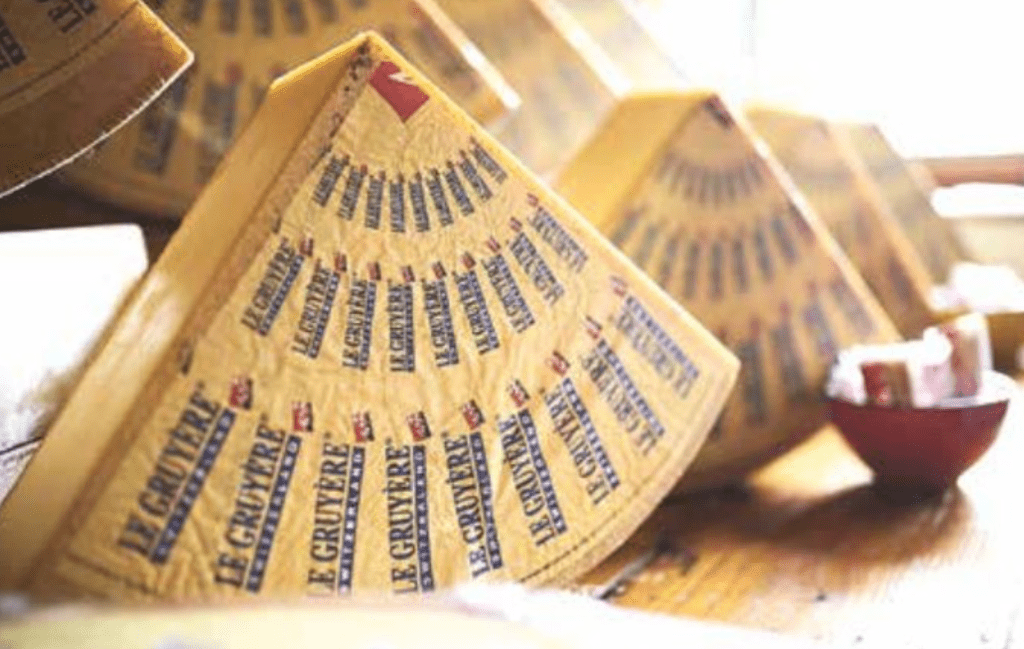LE GRUYÈRE AOP – AN AWARD-WINNING SWISS CHEESE
February 1, 2023 | 8 min to read
Michael Spycher, cheesemaker at Mountain Dairy Fritzenhaus in Bern, Switzerland, claimed the World Champion Cheese title at the 34th annual World Cheese Championships in Madison, WI, with his aged Gourmino Le Gruyère AOP. This hard cheese, celebrated for its fruity and caramel notes, outperformed over 3,000 entries to earn a remarkable score of 98.423. Le Gruyère's production, steeped in history and tradition, showcases unique methods using copper vats and aging on spruce boards, with a protected AOP designation ensuring its quality and origin.

If Michael Spycher, cheesemaker at Mountain Dairy Fritzenhaus in Bern, Switzerland, said he felt on top of the world last March, he wouldn’t have been exaggerating. He was. It was March 3, to be specific, in Madison, WI, at the 34th annual World Cheese Championships that Spycher’s Gourmino Le Gruyère AOP earned the World Champion Cheese title. The 12-plus month-aged hard cheese, with its fruity sweet note and light caramel flavor, earned its first place on the podium competing against more than 3,000 cheeses from 29 countries in 141 categories. This competition is more like the Olympics than the Oscars where technical judging and top points rather than popularity determine the winner. Speycher’s 2022 entry earned a near-perfect 98.423 out of 100. This isn’t Speycher’s first time as Big Cheese. His Le Gruyère AOP earned this award in 2008 and 2020, as well. Like the first two, this third title has sparked renewed excitement by connoisseurs on both sides of the Atlantic to learn more about this native Swiss cheese.
“We produce the traditional Gruyère, which is available as mild, surchoix and reserve. It takes passion and daily efforts and monitoring of the processes, skilled staff and milk farmers who produce high-quality milk,” says Spycher, now home at his Mountain Dairy Fritzenhaus located 20 miles northeast of the city of Bern.
Spycher’s location, first founded for cheesemaking in the mid-1800s and an official Le Gruyère AOP cheese dairy since 1943, means that his operation is a ‘satellite dairy’. The heart of Gruyère production is the namesake Swiss town of Gruyères, located 40 miles south of Bern. This quaint and medieval-looking town, with its cobblestone streets, is in the Fribourg canton of Switzerland some 40 miles south by car from Bern. Like states in the U.S., Switzerland is made up of cantons. Fribourg borders Bern like New Jersey borders New York. Bern, like New York, is the name of both a city and of a canton or analogous state, the latter of which is where Spycher is based. Bearings set, it’s the natural geography of Gruyères that gives birth to its same-named cheese.
Nearly a Millennia in the Making
Gruyères sits atop a small hill and along the La Sarine River at the foot of the Pre-Alps. The combination of freshwater, cattle and rich pasturelands has made this a natural cheese production dating to Roman times. Centuries before, legend tells Vandal King Gruerius saw a crane (called ‘grue’ in French) flying across a red sunset sky and stopped to build a town. Today, the flag of Gruyères features a white bird on a red background, and grue is said to be the origin of the town’s name. Fast forward, and its written records from the year 1115 tell of the official start of Gruyère’s cheesemaking history. So, the story goes, the first Count of Gruyère built the Church of Rougemont. He then taxed surrounding farmers to pay for its upkeep using cheese as currency. Monks used the cutting-edge tools of the time, i.e., kettles, strainers and molds, to ensure the cheese had a consistent quality, then resold it. Less than a century later, Gruyères’ entire economy centered on cheese.
“Medieval chronicles from the 12th century mention the expertise of the region’s inhabitants, who turned the milk production of their herds into full-fat cheese,” says Denis Kaser, marketing manager for export for the Interprofession du Gruyère, in Pringy, Switzerland.
The cheese sold in Gruyères had become incredibly popular by the 14th century, and because it was a hard mountain cheese, it was able to travel well over long distances, says Josh Windsor, affineur and manager of the Long Island City caves of Murray’s Cheese, a New York City-based artisanal cheese and specialty foods retailer and wholesaler that sells Gruyère AOP in the U.S. “Merchants started trading Gruyère, and it became available throughout Europe. Other cheesemakers learned the techniques to make Gruyère and similar cheeses started to be produced in Austria, Germany, France and Italy. Many of these cheeses carried the same name of the cheese they were modeled after, Gruyère.”
Discussions that started a century ago led to Le Gruyère being granted its AOP (Appellation d’Origine Protégée) in 2001, which was recognized at the European level since 2011. The AOP label means the milk used to make the cheese is sourced from the same region where it’s made and aged. Today, there are 160-plus creameries in villages throughout the designated area in Switzerland that carry on the tradition of making Le Gruyère AOP. Buyers can tell if a product is authentic Gruyère cheese if it bears the AOP logo and is made in Switzerland.
“Both the French and the Swiss wanted to claim the name for themselves. It was a hard-fought legal battle, but when it was settled, Switzerland was able to keep the Gruyère name for its AOP designation, while the French can use Gruyère for an IGP designation. Elsewhere the ability to call a cheese Gruyère varies from country to country,” says Murray’s Windsor.
Of note, in January a U.S. District Court ruled cheese made outside the Swiss-French region where it originated can be called Gruyère. Thus, U.S. cheesemakers can make, mark and market cheese with this name.
The Cheesemaking Process
There are two key steps in Le Gruyère AOP-making process to be sure the cheese attains the texture and flavor connoisseur’s love, says Daniel Schnyder, director of imports and licensing at Emmi Roth, with headquarters in Lucerne, Switzerland and a U.S.-based corporate office in Fitchburg, WI. “First, the milk is poured into copper vats, not stainless steel. During the cheesemaking process, copper ions filter from the vat and bind to milk proteins, which remain in the cheese. Copper also heats evenly throughout versus stainless steel, both influencing the unique texture and flavor of Gruyère cheese. Copper also triggers minimal lipid oxidation, which targets the sharp flavor profile that Gruyère cheese is known for. Then Le Gruyère AOP is cellar-aged on traditional spruce boards. The spruce soaks up the right amount of moisture from the cheese to ensure it ages properly.”
A great place to see these steps in action is at La Maison du Gruyère in Gruyères. Cheese is made here two to four times daily and visitors can watch. Headsets are available to translate the audio, narrated by a friendly cow, into English and several other languages.
“Our tour includes five sensory experiences,” says Isabelle Demonchy, reservations specialist. “You can hear sounds like cowbells from the stairway to the exhibit, smell the earthy aroma of hay, touch equipment such as milk canisters, see videos and photos of cheesemaking, and of course taste.”
Types and Tastes
Le Gruyère AOP can vary in types and tastes principally based on how long it’s been aged.
“Gruyère is a great cheese to learn the influence that affinage plays in cheesemaking. To be called Gruyère, the cheese must be aged for at least five months, but it can be aged much longer. Many age profiles can be found. Doux or sweet (around five months old) and reserve or surchoix (more than 10 months old) are the most common. As the cheese ages, the flavors become more concentrated and richer, while the paste becomes firmer and brittle. The salt also becomes concentrated, so you may find wheels labeled mi-salé or semi-salty (usually around seven months old) and salé or salty (usually around nine months old). Extra-aged versions are labeled vieux and can be matured well beyond 14 months. These will be riddled with crystals and have intense meaty flavors. The fruit aromas start to venture into alcoholic at this point. Think pear brandy more than ripe pear,” explains Murray’s Windsor.
There’s also Le Gruyère d’Alpage AOP. It’s a more terroir-driven version of Gruyère and made from the milk of cows grazing in the high alpine pastures between mid-May and mid-October. The curds are cooked in a copper vat over an open flame, which scalds the milk, so the smokey notes are more pronounced.
“Le Gruyère d’Alpage AOP is exclusively pressed in cloth. The wheel of cheese is slightly smaller, around 25 kilos (55-pounds). The beginning of autumn is when the Alpine herdsmen bring their herds back down the mountains for the winter. This process is called the ‘désalpe’, and it is fittingly celebrated,” says the Interprofession du Gruyère’s Kaser.
Cheesemakers at Emmi Roth also create a Kaltbach Cave-Aged Le Gruyère AOP, which is aged for at least 12 months, says Schnyder. “We take wheels of the highest-rated Gruyère and continue aging them in the 22-million-year-old Kaltbach Cave. The Cave develops a unique earthy flavor to Le Gruyère.
In the Kitchen
Gruyère is often best eaten simply.
“I prefer the mature Gruyère simply with bread or in a fondue,” says Mountain Dairy Fritzenhaus’ Spycher.
However, there are so many more ways to enjoy Gruyère. For example, age, seasonality and the work of the affineur all play a role in the final flavor and aroma of the cheese.
“When first exploring the diversity of Gruyère, try as many different samples as you can find. Pay attention to the producer and note the flavors that you prefer. Each maker of Gruyère has a unique aroma profile that they develop in their cheese. Find one that you like and explore the differences throughout the year. Also, try their young and mature versions. There is always something new and exciting to be discovered in a piece of Gruyère,” suggests Murray’s Windsor.
In general, younger Gruyère tends to melt best. Use this age for making a Croque Monsieur or other melted cheese sandwich or for melting over a classic French onion soup. Both a young doux or older reserve works well for making fondue. If the label doesn’t specify the age, price is often a good guide. The longer a cheese is aged, the more labor is required in its production, which can increase the price. To add the more complex flavor of an older Gruyère to a dish, so in a way that’s not reliant on a smooth texture. Melted aged Gruyère tends to be grainy. Try adding it to a breadcrumb topping on macaroni and cheese, instead of nestled among the pasta or as the base of the bechamel sauce.
While ages-old uses remain favorites, many celebrity, restaurant and home chefs are finding new and trendy ways to use Gruyère, says Emmi Roth’s Schnyder. “This includes on pizzas, stirred into polenta and risotto, and in sweet and savory desserts.”

